Our slightly overdue, (thanks to the Adventure games being so huge,) poll winner for March was psyche by Zenith Nadir. A dungeon crawler divided into two halves meant to represent the zenith of Zenith and the nadir of Nadir. It may sound like an introspective work, of a teenager exploring who they are and what that means, but really it's just two short dungeon crawlers where one takes a serious tone while the other opts to revel in nonsense. Nadir gets to take advantage of his evolving aliases in the ZZT community and turn them into labels for psyche. Zenith showed up, starting going by Zenith Nadir, and then eventually simply Nadir. For the sake of consistency, I'll be going with Nadir here, though this is obviously one from the Zenith Nadir era.
While I was always a fan of Nadir's work throughout the years, in particular Frost one and two, psyche was a blind spot for me that I don't think I've so much as even glimpsed at until playing it for this article. Given my tastes in ZZT worlds at the time of its release, as well as my interest in Nadir's creative works in later years, it's kind of remarkable that I hadn't actually played this one before.
Nadir was a tremendous force in the ZZT community, especially in z2's most active years, not only being a regular on forums and IRC chat rooms but a member of z2's staff for a time as well. As such, it was pretty much impossible for anybody throughout most of the 2000s to interact with the community and not have come in contact with Nadir. Combine this with some successful ZZT releases, and it's a safe bet that pretty much any game Nadir worked on will have some record of how it was received.
Psyche has a few reviews from the z2 era, which the game just barely predates. As z2 launched without a review system, few older titles have any reviews unless they're either true classics, notable disasters of ZZT history, or by authors that attracted a fan base. Seeing some positive takes on the game from 2002 and 2003 for psyche should be enough to be cautiously optimistic. All the same, those reviews are now almost entirely in their twenties, and the ideas of what a good ZZT game were then compared to now can often be radically different. Jokes gets outdated, shock humor stops being particularly funny, and gameplay loops now get compared to titles released with decades to study the merits and flaws of past games.
But also it is a Nadir game, and so far with these Closer Looks, he's held up pretty well. Dragon Woods was a strong early adventure/RPG with colorful graphics and humor thanks to its slightly-whiny wizard protagonist. Lebensraum set a new standard for ZZT action games back in 1999, while still being a lot of fun to blast through this past September. The ZZT Dizzy Games take the Codemasters originals and repackage them in a form way far friendlier to players than the originals. I'd blasphemously state that they're more approachable than the real deal today, though I can't imagine a situation emerging where somebody simply has to play either a ZX Spectrum Dizzy or one of Nadir's ZZT equivalents. Frost and its sequel show a now-adult Nadir's comic book world brought to ZZT with some of the platform's most impressive looking boards (and great not-by-Nadir soundtracks to boot) with some respectable dungeon crawling gameplay.
Really, the only time I've seen Nadir miss when covering one of his releases, was his chapter in the collaboratively-made Death Gate, where some odd coding decisions made dungeon crawling through Nadir's temple setting an exercise in frustration as enemies were frequently and unknowingly invulnerable to players' attacks.
To slot this one in early, psyche is ultimately on the weaker side of things. It's a full fledged dungeon crawler with two short variants to play. One of which suffers from its own set of issues that reminds me rather unfortunately of Death Gate. The other, faring better in terms of gameplay, suffering from a lot of writing that says nothing. From the reviews, you'd be led to believe psyche to be an insight into Nadir's soul, exploring the cartoonish and cheerful world of Zenith and then contrasting it with the dark and brooding Nadir. Perhaps Nadir intended it to be exactly that, but I don't really see it. What I see is one dungeon crawler with bizarre enemies and characters that were probably funnier to players still in adolescence, and a second dungeon crawler that dedicates all its adjectives to describing the dead bodies those that died to the dungeon's demonic inhabitants.
By no means is this a miserable experience however! Psyche feels like an average twenty-something ZZT game. It has a clear style in mind, understands what it wants players to do, guides them towards their goals, and eventually does the obligatory big reveal at the end. It's just kind of outdated today, with its twists now predictable and its flaws now crystal clear to someone with a better idea of what works in ZZT and what usually doesn't. Were I to drop my own review on the game, it would not receive another five out of five rating like those who were the target audience did, but I wouldn't say this is a bad game overall.
What was Nadir up to here? Why did the game resonate with those that played it then, and why does it feel flat today? Get ready for a double feature as we explore the zeniths and the nadirs of psyche
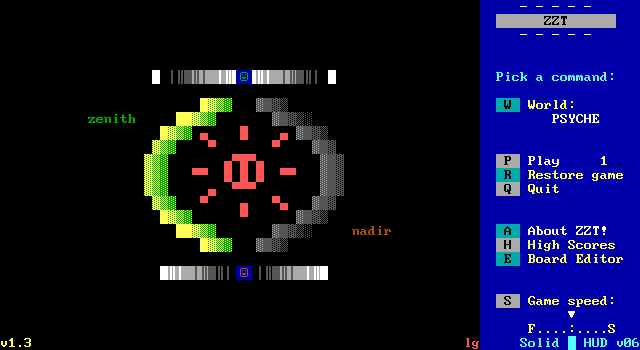
I Can Be Your Angle or Your Devil
Sorry. Impossible to not think of that meme.

The first thing that greets players when they start the game is an art board, a rather unusual welcome compared to menus, stories, or simply dropping players right into the action. Nothing is said of the image depicted, leaving players to make their own mental note of it for later. Although this symbol is shown regardless of which of the game's two paths players take, it only appears on one of those paths, making it a strange choice to make it the very first thing players see.
What you're looking at is a spade with an inverted cross in the middle. On the Nadir path, its a recurring symbol frequently carved into the bodies of those who did not survive the dungeons. On the Zenith path, it's merely a pretty picture to look at before the gameplay begins. For integration into the narrative, it's nothing more than fluff.
The art is a great example of Nadir's steady development into becoming one of the premier artists of ZZT in the 2000s with its impressively round[1] ring circling the symbol which itself has some very strong curves for the usually angular ZZT. It's certainly impressive on a technical level at least.
On that Nadir path, it exists to add a sense of mystery to the world, with the protagonist constantly noticing it and wondering what it represents. Players receive no clues to decipher, hoping only that eventually the meaning will make itself apparent. It never does, making it little more than smoke and mirrors to make things seem a little more interesting than just fighting one's way through a dungeon.

After gawking at the pretty pictures, Nadir presents a more abstract scene, and one that's a bit easier to try and attach meaning to. On the left column, a fade from a warm red to a deep purple that goes from top to bottom. On the right, a similar fade from cooler blue to the same dark purple, this time going bottom to top. The innermost square presents a light/dark motif while the green and brown square are a more personalized take on the same concept. The character of "Zenith" uses dark green and the character of "Nadir" uses brown for their respective appearances. They're two sides of the same coin, etc. etc.
There is a recurring theme of "equilibrium" to the game that can only really be noticed after completing both paths and being able to compare the endings. Though where the theme is most apparent comes not from gameplay, but looking at the board list in the editor.
Nadir incorporates this theme into the very structure of the game itself. Take a look at the board names in the file viewer, and you'll see that the Zenith path starts high on the board list and reaches the center of the board list as the path plays out. The Nadir path begins immediately afterwards, but is implemented backwards so that its end is also in the center of the board list with the earlier boards appearing towards the bottom.
On the Zenith path players have a goal of stopping something at the bottom of the dungeon. On the Nadir path, the goal is to ascend to the surface in order to escape the dungeon instead. Either way, players are attempting to reach the middle, not the end.

Although the game is split into two discrete paths, this is Nadir's game and players have to do as Nadir decrees. This board isn't the expected fork in the road where players can decide which path they'd like to play. Instead, Nadir leaves it all to chance with an object randomly picking the scenario for players.
Removing the player from decision-making entirely[2] is a bold choice, though it's one that works well with both sides' stories ultimately being about how Nadir is the one in control in his creations. After all, there are only two choices to begin with, and the decision is made for you almost immediately upon starting. The player's unrelenting submission to Nadir's whims extending even to the meta-boards that aren't tied to any side of the game is worth the cost of maybe ten whole seconds of delay when trying to play the half not chosen the first time.
Plus it makes it a lot easier to decide which side to try first. Though, at the time, knowing little more than "Zenith = Silly. Nadir = Serious", I was hoping to start with Nadir as I suspected it would be the lesser of the two halves.
The Story of Zenith

You wake up with no memory of who you are or how you got here. The world appears to be symmetrical, going so far as for there to be twin suns hanging in the sky. Otherwise lost in a featureless plain, the protagonist enters the round home in hopes of finding some answers.
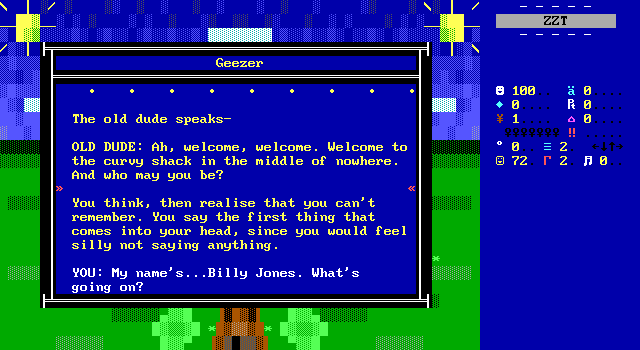
Here they meet an old man who just so happens to be a wizard! Him and his wizard pals used to live in the caverns beneath this home, until an experiment gone awry released an strange green light that corrupted everything, slowly killing off the wizards leaving just this one as the sole survivor. In order to clean up the mess below, the player has been summoned, finally arriving more than two centuries after call the was made.
Self-conscious about his amnesia, the protagonist on this path opts to invent an alias for themselves. Billy Jones at your service. Billy agrees to clean out the depths in exchange for a trip back home. This is easier said than done as the corrupt caverns are now teeming with absurdities that are as deadly as they are strange. At least that's the intent.
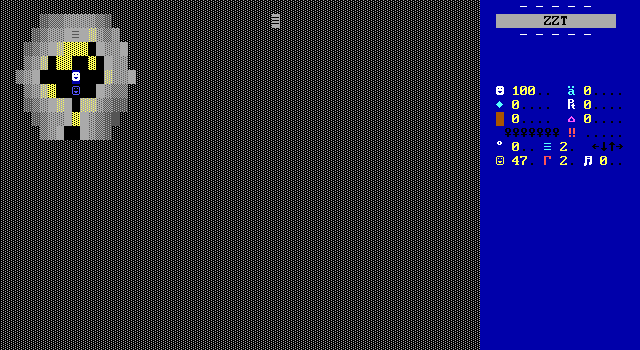
Armed with a sword provided by the wizard, Billy begins his foray into the underground, where players are to be entertained with unusual enemies, odd-ball NPCs, and some cameos not of ZZTers, (well, one ZZTer,) but of ZZT elements. The cast taken straight from ZZT itself includes a lion, the editor cursor, a stone of power, and a roton. Players go in expecting the typical dungeon crawler experience, with the added twist of a colorful cast with plenty weird ZZTer humor to elicit a much different atmosphere than the expected gloom the ZZT dungeon crawler genre is known for.
The greater story here serves as little more than an excuse to put the player into the dungeon. Nothing and nobody Billy meets has anything to do with anything really. It's an intentional choice no doubt, with Nadir focusing on the humor that can be dropped in as needed by just creating another NPC to speak with. The non-enemies are here to provide a few laughs to hold players' attention during their brief dive towards equilibrium until the truth can be revealed.
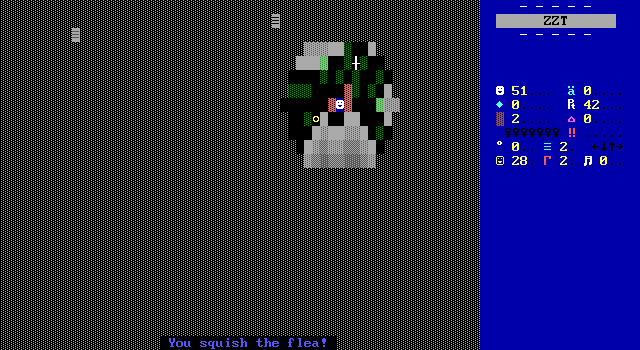
Much of the journey consists of getting beaten down by the surprisingly agile and durable enemies that lurk underground. Most of the trouble comes from the fact that Billy's offensive capabilities are exclusively sword based, making all combat happen in melee range.
Were I playing this when it was a contemporary release, then perhaps the humor of the unexpected enemies and their text would have landed better, making the difficult combat more enjoyable. Instead it's a whole lot of jokes via randomness that stopped being funny long ago mixed with enemies that move too rapidly to hit reliably out in the open. Even if the humor was a hit, surviving long enough to see it all would remain a major hurdle for players to clear.
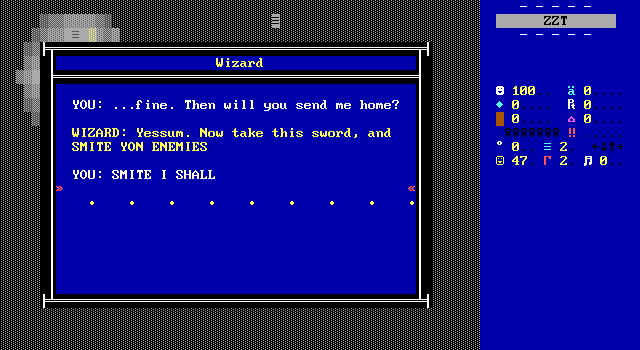
The usual "Nadirisms" are out in full force with this one. These moments of characters pivoting abruptly to terse all-caps dialog can be found everywhere you look. If you were playing Nadir's games when this sort of thing was the pinnacle of comedy like I was, it can feel almost nostalgic.
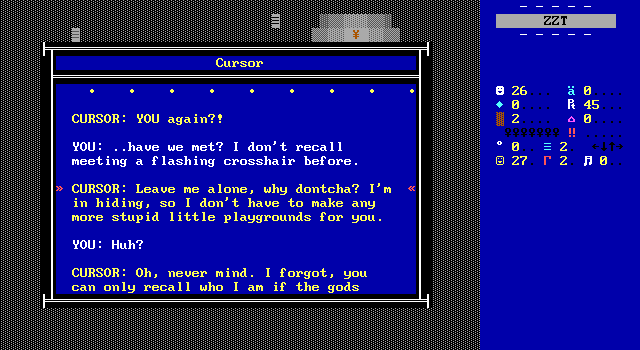
As the game only contains a few enemies to fight, NPCs are scattered throughout the caves to provide some ChickenWire-esque dialog to hold players' interest. Ideally you venture to a new floor, laugh at the unexpected characters, stab a few tamagotchis, and fight your way to the next passage downward. Repeat until credits.
This isn't a bad premise for a ZZT world at all. It's easy to see why folks did enjoy psyche closer to its initial release. You take a genre ZZT is pretty decent at handling, and combine it with comedic writing to make up for any lulls in the gameplay. Or perhaps the focus is the other way around, and the player is instead invested primarily in the game for its comedic elements, with the hack-and-slash action serving as a transition between any LOLs in the writing.
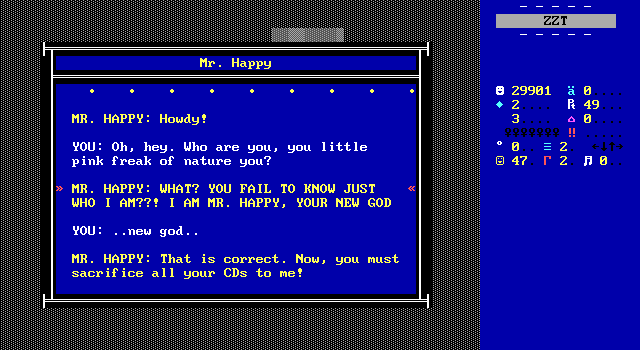
Most of what interested me about the Zenith path was how it actually builds a better story than the more serious narrative seen in the Nadir path. The NPCs are to thank for this, as Billy has the luxury of other characters to interact with, whereas on the Nadir side, the protagonist only runs into one other non-hostile being. The story that develops here has nothing to do with the wizards or the green light that tints the floors of the cave that are used to get players in the dungeon. Instead, Billy's true identity is the subject of discussion, with the NPCs knowing the truth but being unable to speak it as that is what Zenith (the author? the character? both?) has decreed.
Players get to piece together that the protagonist is the player, "ZZT" themselves. Off-handed comments made by the various ZZT entities found on each level provide enough clues to put it together without being particularly subtle. This character revelation, which is never actually confirmed makes no difference to anything. The game plays the same and the overarching story of the corrupting green light remain the same regardless of who Billy is. At best, you can pat yourself on the back for catching the obvious clues of characters recognizing Billy to some degree, but it's still something to uncover over the course of the game.
Most NPCs get little more than than some all-caps dialog with Billy being weirded out by the conversation. For every roton players find that have connection to Billy or other NPCs, they'll come across significantly more characters that are just there to fill up additional text boxes. Billy can try to convince the invisible man that he's not invisible. He can get some extra health from Captain Healthy. He can learn how Death is mistreated by Life. Specifically, how Life frequently nuts him[3] (nmiaow[4]).
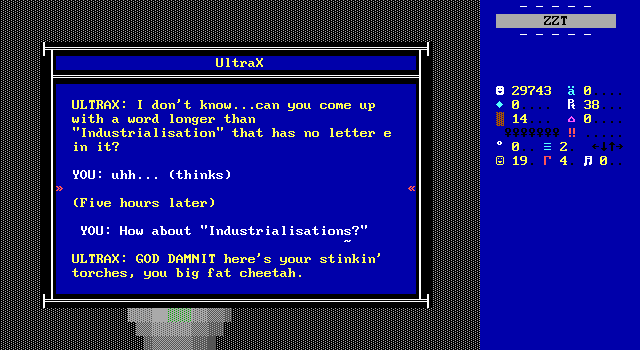
I can post screenshots of the dialog all day, and your eyes will just gloss right over it all. It's easier to see how this game was seen as high-quality if you can put yourself in the shoes of a teenager in the year 2000. Random humor hasn't didn't even have Invader Zim to aspire to yet. This is foundational stuff.
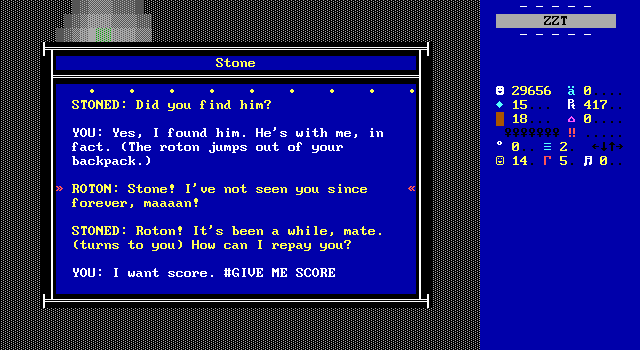
Only a single NPC results in players getting something to do rather than just something to read. Meeting up with the Stone of Power from Super ZZT will get a little spiel about missing hanging out with Roton. Later on Roton can be found and taken back to the stone of power for some hard-earned bonus points.
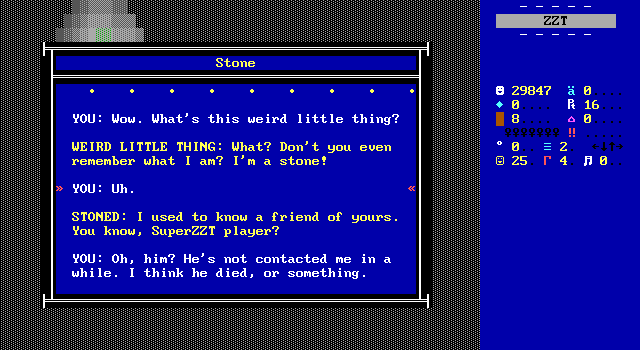
For as much as the comedy passed me by, scrolling down the text to learn that Super ZZT's player is probably did definitely caught me off guard and got a laugh from how surprising the dialog once. Talking with the stone of power ended up being the highlight of the Zenith path for me.
The Zenith path as a whole is very samey, which will unfortunately be a criticism of the Nadir side of things as well. You'll know what you're in for with this path after a single dungeon floor. It's a whole lot of nonsense for the sake of being nonsensical, that even with the variety seen in NPCs still amounts to little that feels unique. Playing it today long past the humor's shelf-life has run out, the game offers very little to fans of ZZT dungeon crawlers and those without a soft-spot for this kind of humor whose heyday has also long past.
With the humor mostly out of commission, all that remains is the game's combat to attempt to assert itself today. Nadir has done a reasonable job with action seen in his other games both before and after psyche, but this one is lacking. I found many of the game's enemies are frustrating to fight, which caused some serious health woes early on. By the time health became more plentiful and more creative enemies took focus, fatigue had already set in. All that remains here is nostalgia for a time when this would have been a good comedy in the eyes of the ZZT community.
- [1] How dare this unofficial upload of Look Around You that splits an episode into two videos does so right in the middle of the part I wanted to link!
- [2] You might think to simply ?ZAP where you please, but a flag is set here for your assigned path resulting in an immediate game over if you try to defy.
- [3] You know, that old British slang about headbutting somebody. #16 on the British dictionary definition for nut!.
- [4] "Not meant in an obscene way", an ancient bit of internet slang that really took off in the ZZT/MegaZeux community in the 90s.


